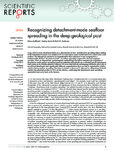Recognizing detachment-mode seafloor spreading in the deep geological past
| dc.contributor.author | Maffione, M | |
| dc.contributor.author | Morris, A | |
| dc.contributor.author | Anderson, MW | |
| dc.date.accessioned | 2016-07-19T14:48:27Z | |
| dc.date.available | 2016-07-19T14:48:27Z | |
| dc.date.issued | 2013-08-01 | |
| dc.identifier.issn | 2045-2322 | |
| dc.identifier.issn | 2045-2322 | |
| dc.identifier.other | 2336 | |
| dc.identifier.uri | http://hdl.handle.net/10026.1/5081 | |
| dc.description.abstract |
Large-offset oceanic detachment faults are a characteristic of slow- and ultraslow-spreading ridges, leading to the formation of oceanic core complexes (OCCs) that expose upper mantle and lower crustal rocks on the seafloor. The lithospheric extension accommodated by these structures is now recognized as a fundamentally distinct “detachment-mode” of seafloor spreading compared to classical magmatic accretion. Here we demonstrate a paleomagnetic methodology that allows unequivocal recognition of detachment-mode seafloor spreading in ancient ophiolites and apply this to a potential Jurassic detachment fault system in the Mirdita ophiolite (Albania). We show that footwall and hanging wall blocks either side of an inferred detachment have significantly different magnetizations that can only be explained by relative rotation during seafloor spreading. The style of rotation is shown to be identical to rolling hinge footwall rotation documented recently in OCCs in the Atlantic, confirming that detachment-mode spreading operated at least as far back as the Jurassic. | |
| dc.format.extent | n/a- | |
| dc.format.medium | ||
| dc.language | en | |
| dc.language.iso | en | |
| dc.publisher | Nature Group | |
| dc.subject | Geodynamics | |
| dc.subject | Geology | |
| dc.subject | Palaeomagnetism | |
| dc.subject | Tectonics | |
| dc.title | Recognizing detachment-mode seafloor spreading in the deep geological past | |
| dc.type | journal-article | |
| dc.type | Article | |
| plymouth.author-url | https://www.ncbi.nlm.nih.gov/pubmed/23903780 | |
| plymouth.issue | 1 | |
| plymouth.volume | 3 | |
| plymouth.publication-status | Published | |
| plymouth.journal | Scientific Reports | |
| dc.identifier.doi | 10.1038/srep02336 | |
| plymouth.organisational-group | /Plymouth | |
| plymouth.organisational-group | /Plymouth/Faculty of Science and Engineering | |
| plymouth.organisational-group | /Plymouth/Faculty of Science and Engineering/School of Geography, Earth and Environmental Sciences | |
| plymouth.organisational-group | /Plymouth/REF 2021 Researchers by UoA | |
| plymouth.organisational-group | /Plymouth/REF 2021 Researchers by UoA/UoA07 Earth Systems and Environmental Sciences | |
| plymouth.organisational-group | /Plymouth/Research Groups | |
| plymouth.organisational-group | /Plymouth/Research Groups/Marine Institute | |
| plymouth.organisational-group | /Plymouth/Users by role | |
| plymouth.organisational-group | /Plymouth/Users by role/Academics | |
| plymouth.organisational-group | /Plymouth/Users by role/Researchers in ResearchFish submission | |
| dc.publisher.place | England | |
| dcterms.dateAccepted | 2013-07-10 | |
| dc.identifier.eissn | 2045-2322 | |
| dc.rights.embargoperiod | No embargo | |
| rioxxterms.versionofrecord | 10.1038/srep02336 | |
| rioxxterms.licenseref.uri | http://www.rioxx.net/licenses/all-rights-reserved | |
| rioxxterms.type | Journal Article/Review |


